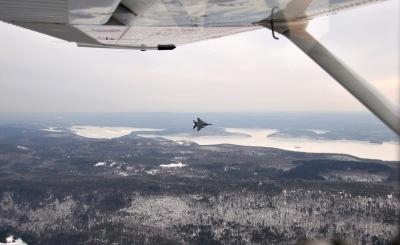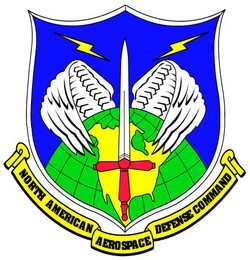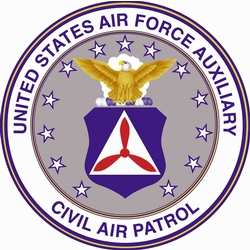Gives Pilots Training In Intercept Of Civilian Aircraft
Pilots assigned to Aerospace Control Alert units have a unique
mission - to defend the U.S. and Canadian homelands by controlling
that airspace and being prepared to respond to threats. Because of
that enormous responsibility, these units routinely train for this
mission. And since the aircraft they would be charged with
intercepting aren't fighter jets, ACA pilots rely on more realistic
"adversaries" to train with.
CAP Photo

Enter the volunteer force of the Civil Air Patrol and their
fleet of small aircraft. Throughout the year, CAP wings across the
country take to the skies during unit training exercises as "tracks
of interest" to give the alert pilots a chance to practice
scrambling and intercepting aircraft in a safe, controlled
environment.
"CAP, as the Air Force Auxiliary, is part of the high-fidelity
training that ensures the United States Air Force is ready and able
to execute the ACA mission around the clock and continue a vigilant
watch," said Mark OBrien, CAP-USAF liaison to 1st Air Force. "The
training the ACA units get from these exercises is crucial, and
it's training they can't get unless they actually go up in the air
and fly against small, general aviation aircraft."
Aside from Air Force ACA pilots, CAP trains with agencies such
as the U.S. Coast Guard and U.S. Customs and Border Patrol,
depending on the region of the country and the needs inherent to
that region. "Our primary mission in flying these types of sorties
is to provide tracks of interest for the Air Force, the Air
National Guard and the Coast Guard," said CAP Col. Leo Burke,
Michigan Wing commander. "We fly a specific flight profile or
multiple profiles that test the ability of the ACA units to respond
to various threats."
Burke, who has planned and flown at least 25 of these missions,
has seen the teamwork involved and the resulting benefits. On one
such mission, in the early morning hours over the skies of Michigan
in January 2006, just before the Super Bowl in Detroit, Burke was
piloting a plane a few thousand feet off the ground when a Coast
Guard helicopter intercepted him and a second CAP aircraft. At the
same time, Air National Guard F-16s were busy intercepting a jet
flying over the Detroit River. Nearby, a KC-135 orbited the area,
ready to provide fuel to the participating aircraft, and somewhere
above it all, an E-3 AWACS plane monitored the exercise. "As a
pilot, that made me feel pretty cool," Burke said. "A lot of pilots
never even see those aircraft at an airshow, let alone get to
participate in a mission with them."

Then, in April 2009, a student pilot stole a Cessna 172 from his
flight school in Ontario, Canada, and flew south into U.S.
airspace. Fighter jets from Wisconsin and Ohio scrambled,
intercepted the plane and shadowed it for nearly seven hours until
it landed in Missouri. When Burke talked to the units later, they
told him the scramble and intercept mission "went perfect.
Everything we practiced with CAP paid off."
"As a CAP officer, that made me feel pretty cool," Burke said.
"That was confirmation that everything we were doing was critical.
We are directly contributing to the safety and security of our
nation."
For the alert pilots, this training is invaluable. "The
relationship Barnes Air National Guard Base has with the
Massachusetts CAP Wing is a strong one. There are multiple benefits
of this relationship and this training. One of the top benefits is
valid threat replication," said Capt. Osme Benedict, a fighter
pilot with the 104th Fighter Wing of the Massachusetts Air National
Guard. "It is always a challenge to find them. CAP carries out a
set of special instructions designed to train our pilots on
intercepting, inspecting and guiding suspect aircraft."
Without CAP, the fighter pilots would have to improvise to
simulate the threat. "If CAP wasn't able to provide this type of
'threat,' we would have to use an in-house jet to replicate a track
of interest similar to civilian aircraft," Benedict said. "But to
accurately replicate a civilian track of interest, you need just
that ... a smaller, slower aircraft."
Because of the CAP training, Benedict said he feels more
confident in his ability to respond to a track of interest. "In our
occupation, action needs to be innate and second-nature, and the
practice we get as alert pilots with these aircraft directly
correlates to our action in real-world scrambles," Benedict said.
"It's always a benefit to get as many 'practice' intercepts in
before the real one happens."

In delivering this crucial training, CAP participates in more
than 200 air defense training exercises a year, totaling more than
1,900 flying hours at the bargain price of $135 an hour. "That
amount covers the prorated maintenance and fuel costs for a CAP
aircraft," said Lt. Col. Chris Sabo, Air Force Auxiliary Plans and
Programs chief. "If the Air Force had to contract for a similar
asset, they could easily pay up to $7,000 per hour." That $7,000
per hour equals out to approximately $13.3 million for an average
year of training, making CAP the more fiscally responsible choice
with a price tag just north of $250,000 a year.
"But the real cost benefit is that CAP is a volunteer
organization and the members are not paid for their services," Sabo
said. "They typically give their time and talents just for the
opportunity to serve our country."
Though the terrorist attacks of Sept. 11, 2001, brought airspace
protection into sharp focus, CAP has been providing for homeland
defense longer than the Air Force has been a branch of the
military. In December 1941, CAP was founded by more than 150,000
citizens who were concerned about the defense of America's
coastline.
"In a post-9/11 world, this is a way for private citizens to
directly contribute to the defense of America," Burke said. "Why
wouldn't we do this for America and the ACA units?"
 ANN's Daily Aero-Term (04.26.24): DETRESFA (Distress Phrase)
ANN's Daily Aero-Term (04.26.24): DETRESFA (Distress Phrase) ANN's Daily Aero-Linx (04.26.24)
ANN's Daily Aero-Linx (04.26.24) Airborne 04.22.24: Rotor X Worsens, Airport Fees 4 FNB?, USMC Drone Pilot
Airborne 04.22.24: Rotor X Worsens, Airport Fees 4 FNB?, USMC Drone Pilot Airborne 04.24.24: INTEGRAL E, Elixir USA, M700 RVSM
Airborne 04.24.24: INTEGRAL E, Elixir USA, M700 RVSM Airborne-NextGen 04.23.24: UAVOS UVH 170, magni650 Engine, World eVTOL Directory
Airborne-NextGen 04.23.24: UAVOS UVH 170, magni650 Engine, World eVTOL Directory





